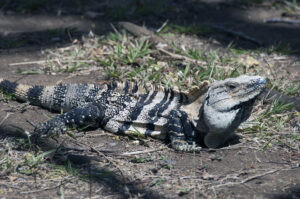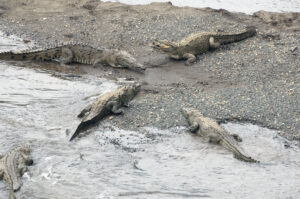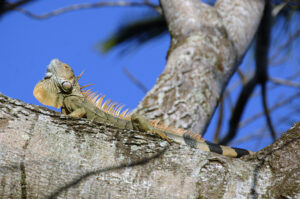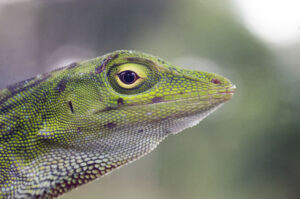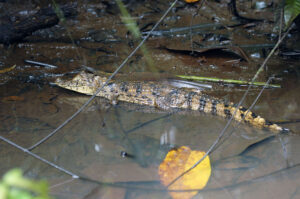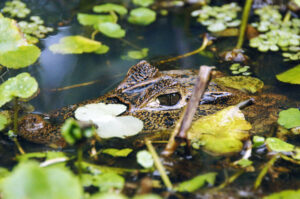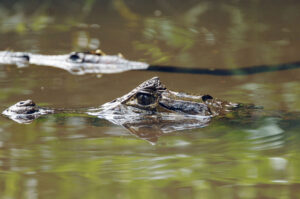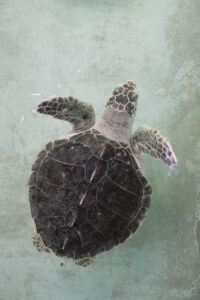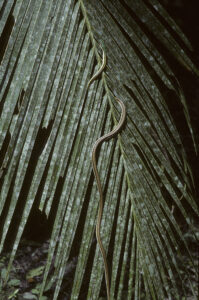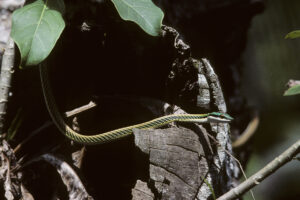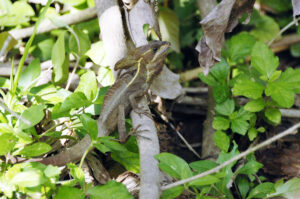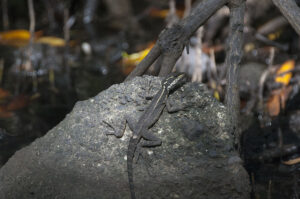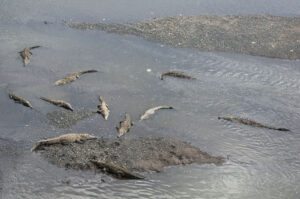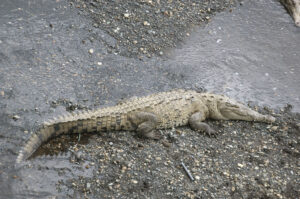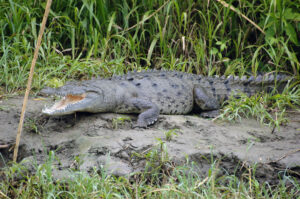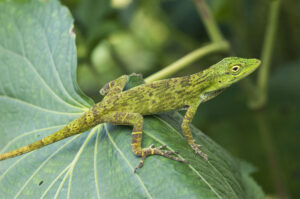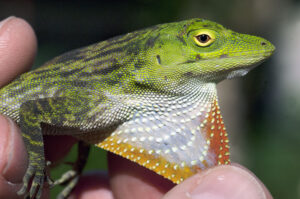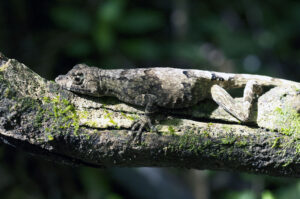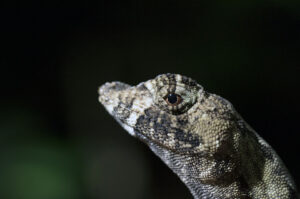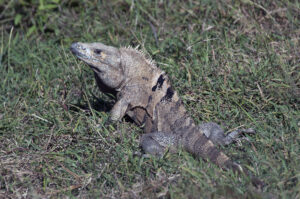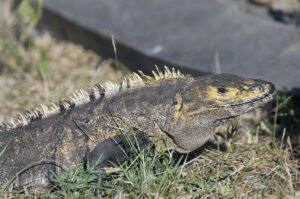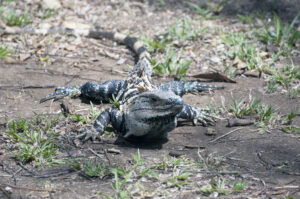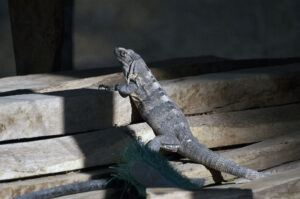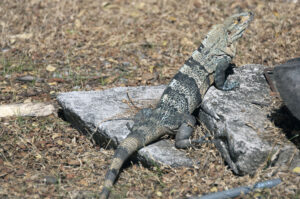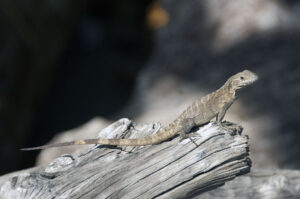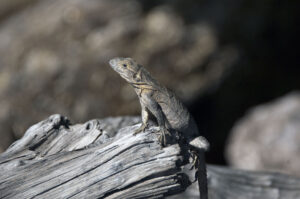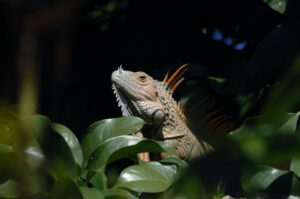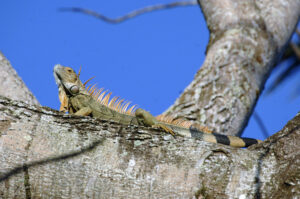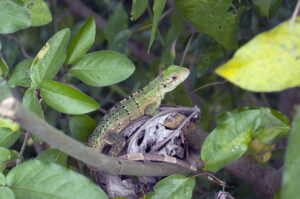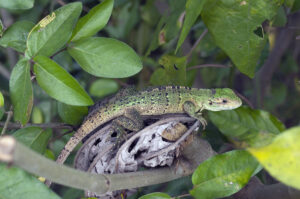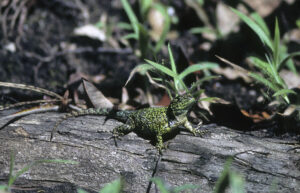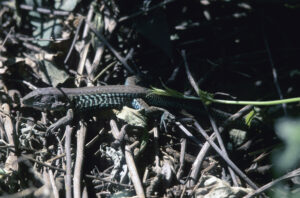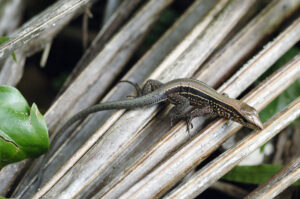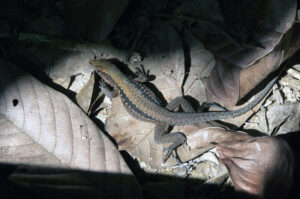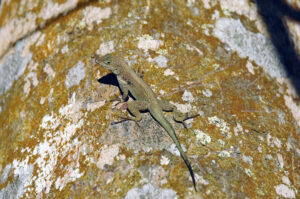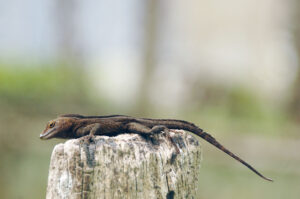Reptiles in Costa Rica and Guatemala
Male black spiny-tailed iguana (Ctenosaura similis), Santa Rosa National Park, Guanacaste, Costa Rica. (Photo copyright © by Kaj Halberg)
American crocodiles (Crocodylus acutus), basking on the shore of Rio Tárcoles, Costa Rica. (Photos copyright © by Kaj Halberg)
Male green iguana (Iguana iguana), displaying in a tree, Tortuguero National Park. (Photo copyright © by Kaj Halberg)
Neotropical green anole (Anolis biporcatus), El Castillo, Cordillera de Tilarán, Costa Rica. (Photo copyright © by Kaj Halberg)
This page deals with a selection of reptiles, which I encountered during a 7 week long stay in Guatemala October-December 1998, and a one month long stay in Costa Rica January-February 2012. Families, genera, and species are presented in alphabetical order.
A number of pictures, depicting unidentified species, are also shown. If you are able to identify any of these animals, or if you find any errors, I would be grateful to receive an email. You may use the address at the bottom of this page.
Alligatoridae Alligators and caimans
This family contains 8 species of crocodile-like animals, 2 alligators in a single genus and 6 caimans in 3 genera. Alligators live in the United States and China, whereas caimans are restricted to Central America and northern South America.
Caiman
A small genus with 3 species, found from southern Mexico southwards to central Argentina.
The generic name is a corruption of a Carib name of these animals, acayouman.
Caiman crocodilus Spectacled caiman
This rather common animal grows to a length of about 2.5 m, weighing up to 40 kilos. It has a spectacle-like ridge between its eyes, giving rise to its common name. It is found from southern Mexico southwards to northern Bolivia and central Brazil, and has also been introduced to the United States, Cuba, and Puerto Rico.
The specific name was given in allusion to its crocodile-like appearance.
Spectacled caimans, Tortuguero National Park, Limón, Costa Rica. (Photos copyright © by Kaj Halberg)
Cheloniidae Sea turtles
Of the world’s 7 species of sea turtles, 6 belong to this family. These animals are characterized by having shields covering back and belly, firmly attached to vertebra and ribs. The back shield is called a carapax, the belly shield plastron. Both shields are covered in scutes, consisting of horn-like keratin. The scutes on the back are arranged in 3 longitudinal rows.
The seventh species is the huge leatherback turtle (Dermochelys coriacea), which forms a separate family, Dermochelyidae. It has no scutes, but a leathery skin that covers 5 or 7 longitudinal ribs along the back.
Although sea turtles spend about 98% of their life in the oceans, the females must get ashore, when they are about to lay eggs. With a great effort, they crawl ashore on a sandy beach, where they use their hind flippers to dig a hole above the high tide line.
When a female has finished digging, she lays a number of white eggs, often between 80 and 100. They resemble table tennis balls, but are soft, so as not to break when they fall into the hole. When the egg-laying is over, the female covers the eggs, throwing sand about with her flippers to camouflage the spot. Then she returns to the sea.
Some sea turtle species lay eggs several times in a season, in some cases up to 11 clutches. It sounds incredible, but the female often returns to the beach where it hatched many years before. How she is able to do that remains a mystery. One theory is that the animals are imprinted by the physical and chemical composition of the beach, and that they are able to use the Earth magnetism to navigate from.
Earlier, adult sea turtles didn’t have many enemies. Tidligere havde voksne havskildpadder ikke mange fjender. Large sharks and orcas (Orcinus orca) may take some, although it is a rather bony mouthful. However, with the spreading of humans to the entire planet, the situation is quite different, and all eight species are declining drastically. The eggs are dug up and eaten by poor settlers, or eaten as a delicacy in restaurants, or because they are regarded as an aphrodisiac. Many adult turtles are also eaten by people.
The hawksbill turtle (Eretmochelys imbricata) is persecuted due to its beatiful carapace, from which jewelery, combs, and other items are carved. Numerous carapaces are imported by the Japanese. Even entire, varnished carapaces are sold as souvenirs, among other places in Indonesia.
Tens of thousands of sea turtles drown in fishing nets or become damaged by the propellors of boat engines. Young turtles die from eating waste oil and lumps of tar, floating on the surface. Many leatherbacks eat plastic, which resembles their main food, jellyfish. The plastic cannot be digested and gets stuck in the intestines, causing the animal to die from starvation.
Lepidochelys Ridleys
A small genus of 2 species, the olive ridley (below) and the endangered Kemp’s ridley (L. kempii), which is restricted to the Gulf of Mexico.
The generic name is derived from Ancient Greek lepidos (‘scale’) and chelys (‘turtle’), perhaps alluding to the scaly appearance of the head and flippers of these animals. The common name is of unknown origin.
Lepidochelys olivacea Olive ridley
This rather small species, growing to about 75 cm long, is the most abundant of all sea turtles. It occurs in all warmer seas, primarily in the Pacific and Indian Oceans. It is known for its spectacular synchronised mass nesting, called arribada (Spanish for ‘arrival’), where thousands of females gather on the same beach to lay eggs. One of these places is Playa Ostional, Guanacaste Province, Costa Rica.
The specific name alludes to the olive tinge on this otherwise brownish or greyish animal.
My encounter with this animal in India is related on the page Animals – Reptiles and amphibians: Reptiles and amphibians in the Indian Subcontinent.
Young olive ridley, photographed at a breeding centre for threatened animals, Monterrico, Guatemala. (Photo copyright © by Kaj Halberg)
Colubridae Grass snakes and allies
This is the largest family of snakes, comprising over 250 genera and more than 2,100 species. They are found on all continents, except Antarctica. Members of the family are non-toxic, with a few exceptions.
Leptodrymus pulcherrimus Striped lowland snake
This beautiful snake, the only member of the genus, may be identified by its emerald-green head, contrasting with the brownish, greenish, yellowish, or sometimes bluish body, which has a longitudinal black stripe on each side. It is distributed from Guatemala eastwards to Costa Rica, found in various forest types from the lowlands up to elevations around 1,300 m.
The scientific name is derived from Ancient Greek leptos (‘thin’) and drymos (‘forest’), originally from drys (‘oak’), and a superlative of the Latin pulcher (‘beautiful’), thus ‘the very beautiful, thin (snake) of the forest’. A very descriptive name, indeed!
Striped lowland snake, Tikal National Park, Guatemala. The stripes on this individual are rather faint. (Photos copyright © by Kaj Halberg)
Corytophanidae Casque-headed lizards, helmeted lizards
These animals, comprising 3 genera with 9 species, are found from Mexico southwards to Ecuador.
Basiliscus Basilisks
A small genus with 4 species, distributed from Mexico eastwards to northern South America.
The generic name refers to the basilisk, a creature in Greek mythology, which is part rooster, part snake, and part lion. It was said that it could turn a person to stone, merely by looking at him or her. The word is derived from the Greek basiliskos, a diminutive of basileus (‘king’), thus ‘small king’.
Basiliscus vittatus Brown basilisk, striped basilisk
The species is native to Mexico, Central America, and north-western Colombia. The male has a large crest, a yellow line running from the eye along the side to the rear legs, and white or yellowish patches around the mouth, and on the throat and upper breast. The female is smaller and lacks the crest.
Young animals are able to run along the surface of the water at a terrific speed, its legs moving so fast that they resemble a whisk. For this reason, the species is sometimes called Jesus Christ lizard, although that name is usually reserved for the common basilisk (B. basiliscus).
The specific name is Latin, meaning ‘banded’, referring to the stripes on its body.
Male brown basilisk, Cahuita, Limón, Costa Rica. (Photo copyright © by Kaj Halberg)
Brown basilisk, female or young male, basking on a rock among mangrove trees, Puerto Jiménez, Peninsula de Osa, Costa Rica. (Photo copyright © by Kaj Halberg)
Crocodylidae Crocodiles
These huge reptiles, altogether 17 species in 3 genera, are widely distributed in tropical areas, with 3 species in Africa and western Madagascar, 9 species in Asia, New Guinea, and northern Australia, and 5 in the Americas.
Crocodylus Typical crocodiles
A genus of 13 or 14 species, distributed in warm areas across the globe. The status of the Bornean crocodile (C. raninus or C. porosus ssp. raninus), remains unclear.
The generic name is derived from krokodeilos, the Ancient Greek term for these animals.
Crocodylus acutus American crocodile
This large crocodile, growing to 6 m long and weighing up to 900 kg, is widely distributed, found from southern Florida southwards through the Caribbean to northern Venezuela, and along the west coast of Mexico eastwards to Columbia, Ecuador, and extreme northern Peru.
A famous place to watch a large number of this crocodile is from a bridge across Rio Tárcoles, on the Costanera Sur Highway (Route 34), north of Jaco, Costa Rica.
The specific name is Latin, meaning ‘sharpened’, alluding to the long, pointed snout of this species.
American crocodiles, basking on the shore of Rio Tárcoles, Costa Rica. (Photos copyright © by Kaj Halberg)
American crocodile, Rio Blanco, Limón, Costa Rica. (Photo copyright © by Kaj Halberg)
Dactyloidae Anoles
This family of lizards ranges from south-eastern United States southwards to Paraguay and Brazil. Some authorities regard it as a subfamily of Iguanidae (below). Formerly, these animals were placed in the family Polychrotidae.
The common name stems from anoli, a Carib term for these animals.
Anolis
The true anoles, comprising more than 425 species, were traditionally all placed in this genus, but recent genetic research suggests them divided into 8 genera: Anolis, Dactyloa, Deiroptyx, Audantia, Chamaelinorops, Xiphosurus, Ctenonotus, and Norops.
Anolis biporcatus Neotropical green anole
This large species lives in various types of forest, from Mexico eastwards to Colombia and Venezuela. Previously, populations in south-western Colombia and Ecuador were included in this species, but are now regarded as a separate species, A. parvauritus.
The specific name is derived from the Latin bi (‘double’) and porca (‘a ridge between two furrows’). What it refers to is not clear.
Today, some authorities call this animal Norops biporcatus, but until further research has clarified its status, I retain the name Anolis biporcatus.
Neotropical green anole, El Castillo, Cordillera de Tilarán, Costa Rica. (Photos copyright © by Kaj Halberg)
Unidentified anole, Rincon de la Vieja National Park, Cordillera de Guanacaste, Costa Rica. (Photos copyright © by Kaj Halberg)
Iguanidae Iguanas
All but one of the 9 genera of this family, comprising about 47 species, are native to the Americas, distributed from south-western United States and the Caribbean southwards to northern Argentina.
The only non-American genus is Brachylophus, found on Fiji and formerly also on Tonga. It is thought that the progenitor of these animals once drifted on logs from South America 8,000 km across the Pacific.
Ctenosaura Spiny-tailed iguanas
These large lizards, comprising about 15 species, are found from northern Mexico southwards to Panama. They somewhat resemble the Old-World monitor lizards (Varanus).
The generic name is derived from Ancient Greek ktenos (‘comb’), referring to the crest along the back of adult males, and saura (‘lizard’).
Ctenosaura similis Black spiny-tailed iguana
This species is distributed from southern Mexico eastwards to Panama. The adult male is grey or pale brown with black vertical stripes on the body, a large crest along the back, and often with bluish parts on front legs and head, especially around the mouth. The female is brownish with fainter stripes, and the crest is very small. Young animals are bright green, with age changing to brownish.
The specific name is Latin, meaning ‘similar to’ – to what is not clear.
Adult males of black spiny-tailed iguana, Palo Verde National Park, Guanacaste, Costa Rica. (Photos copyright © by Kaj Halberg)
Adult male, Santa Rosa National Park, Guanacaste, Costa Rica. (Photo copyright © by Kaj Halberg)
Adult female, Palo Verde National Park. (Photo copyright © by Kaj Halberg)
Adult female, Puerto Jiménez, Peninsula de Osa, Costa Rica. (Photo copyright © by Kaj Halberg)
Young male, Palo Verde National Park. (Photo copyright © by Kaj Halberg)
Immature, Capo Matapalo, Peninsula de Osa. (Photos copyright © by Kaj Halberg)
Iguana True iguanas
A small genus with 2 species, the widespread green iguana (below), and I. delicatissima, which is restricted to the Lesser Antilles.
The generic name is a Spanish corruption of iwana, the term for these animals in Taino, an extinct Arawakan language, spoken by the Taino people of the Caribbean.
Iguana iguana Green iguana
The native range of this animal is large, from southern Mexico and the Caribbean southwards to Bolivia, Paraguay, and central Brazil. However, it has been introduced to many other countries and has become naturalized in a number of places. It is regarded as an invasive species in Puerto Rico, Hawaii, and Fiji.
Male green iguana, Tortuguero National Park, Limón, Costa Rica. (Photo copyright © by Kaj Halberg)
Male green iguana, displaying in a tree, Tortuguero National Park. (Photo copyright © by Kaj Halberg)
Young green iguana, Rio Tárcoles, Costa Rica. (Photos copyright © by Kaj Halberg)
Phrynosomatidae North American spiny lizards
Members of this family, comprising 9 genera with about 180 species, distributed from extreme southern Canada southwards to Panama.
Sceloporus Spiny lizards, scaly lizards
A very large genus with about 113 species, ranging from extreme southern Canada southwards to Panama.
The generic name is derived from Ancient Greek skelos (‘leg’) and poros (‘passage’, ‘pore’), alluding to the large pores on the thigh.
Sceloporus taeniocnemis Guatemalan emerald spiny lizard
This colourful lizard is restricted to south-eastern Mexico and Guatemala.
The specific name is derived from the Latin taenia (‘band’ or ‘ribbon’), and the Greek kneme (‘shin’), explained in the original description by American zoologist Edward Drinker Cope (1840-1897) in A contribution to the herpetology of Mexico. Proceedings of the American Philosophical Society, 22: 379-404 (1885). He refers to “two black bands, separated by a brown one, on the posterior face of the thigh.” (Note that he uses the Greek word for ‘shin’ instead of ‘thigh’.)
Guatemalan emerald spiny lizard, Biotopo del Quetzal, Guatemala. (Photo copyright © by Kaj Halberg)
Sphaerodactylidae Geckos
This family, comprising 12 genera and more than 200 species, is distributed in the Americas, the Caribbean, southern Europe, northern Africa, the Middle East, and Central Asia.
The name gecko stems from the call of the Southeast Asian tokay gecko (Gekko gecko), of the family Gekkonidae, rendered as geck-oo or tuc-too.
Gonatodes
This genus contains about 34 species, found from southern Mexico southwards to Peru and northern Brazil, and also on several islands in the Caribbean.
The generic name is derived from Ancient Greek gonato (‘knee’) and oides (‘resembling’), probably alluding to the slender digits, which have prominent swellings in the joints.
Gonatodes albogularis Orange-headed gecko
Males of this species are very colourful, whereas the females are greyish. It has a very wide distribution, found in many Caribbean islands, and from Mexico eastwards to northern South America. Formerly, it was also present in southern Florida, but this population died out in the 1990s.
The specific name is Latin, meaning ‘having a white throat’, derived from albus (‘white’) and gula (‘throat’). This means that the type specimen must have been a female, which has a white throat, as opposed to the male, which has an orange or yellow throat.
Male orange-headed gecko, Cahuita, Limón, Costa Rica. (Photo copyright © by Kaj Halberg)
Teiidae Whiptails, racerunners, and tegus
This family, containing 18 genera with altogether about 175 species, is found in the major part of the Americas.
Holcosus Whiptails, ameivas
A genus with about 18 species, native to southern Mexico, Central America, and northern South America. They were previously placed in the genus Ameiva.
The generic name may be derived from Ancient Greek holkos (a kind of grain), referring to the grain-like, keeled scales on the frontal region of the head of these lizards.
Holcosus festivus Central American whiptail, Central American ameiva
This colourful whiptail is found from southern Mexico eastwards to Colombia, at elevations up to around 1,000 m.
The specific name is Latin, meaning ‘joyous’ or ‘merry’, undoubtedly referring to its bright pattern and colours.
Central American whiptail, Panajachel, Lago Atitlan, Guatemala. (Photo copyright © by Kaj Halberg)
Holcosus quadrilineatus Four-lined whiptail, four-lined ameiva
This species is endemic to Central America, found in south-eastern Nicaragua, Costa Rica, and western Panama, living in open habitats. It may be identified by four yellowish lines, running down the back and sides. Juveniles have blue tails.
The specific name is Latin, meaning ‘four-lined’.
Four-lined whiptail, Cahuita, Limón, Costa Rica. (Photo copyright © by Kaj Halberg)
This four-lined whiptail is sitting on a withered palm leaf, Cahuita. Note the red mites on its body. (Photo copyright © by Kaj Halberg)
Unidentified lizard, Reserva Nacional Hacienda Baru, Costa Rica. (Photo copyright © by Kaj Halberg)
Unidentified lizards, Cahuita, Limón, Costa Rica. (Photos copyright © by Kaj Halberg)
(Uploaded June 2023)
(Latest update April 2024)
